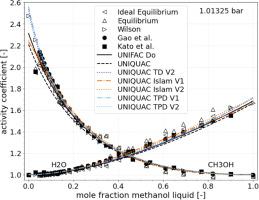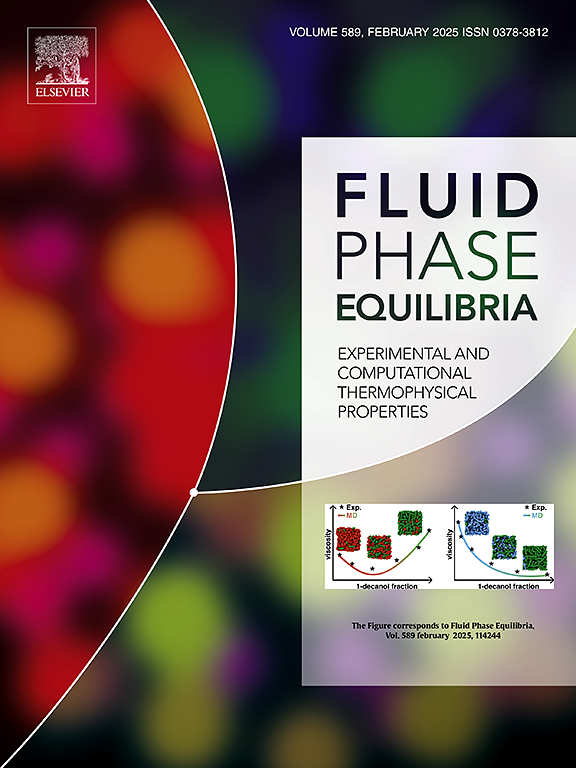压力和温度依赖于甲醇-水混合物的UNIQUAC模型
IF 2.7
3区 工程技术
Q3 CHEMISTRY, PHYSICAL
引用次数: 0
摘要
在UNIQUAC模型的二次温度相关二元相互作用参数中加入了压力相关参数。将得到的甲醇-水混合物活度系数仅与温度相关的UNIQUAC和UNIFAC进行了比较,并与基于298.15 ~ 373.15 K和0.1519 ~ 1.01325 bar的气液平衡计算和Wilson法计算的活度系数进行了比较。该模型显示出总体上良好的一致性。预测的活度系数比没有压力依赖的模型更具适应性,表明进一步改进的潜力。本文章由计算机程序翻译,如有差异,请以英文原文为准。

Pressure and temperature dependent UNIQUAC model for methanol - water mixtures
A pressure dependency is included in a quadratic temperature dependent binary interaction parameter of the UNIQUAC model. The obtained activity coefficients for methanol-water mixtures are compared with only temperature dependent UNIQUAC and UNIFAC, and with calculated activity coefficients based on experimental data between 298.15 - 373.15 K and 0.1519 - 1.01325 bar produced with vapor-liquid equilibrium calculations and Wilson method. This model exhibits an overall good agreement. The predicted activity coefficients are more adaptable than those from models without pressure dependence, indicating potential for further improvement.
求助全文
通过发布文献求助,成功后即可免费获取论文全文。
去求助
来源期刊

Fluid Phase Equilibria
工程技术-工程:化工
CiteScore
5.30
自引率
15.40%
发文量
223
审稿时长
53 days
期刊介绍:
Fluid Phase Equilibria publishes high-quality papers dealing with experimental, theoretical, and applied research related to equilibrium and transport properties of fluids, solids, and interfaces. Subjects of interest include physical/phase and chemical equilibria; equilibrium and nonequilibrium thermophysical properties; fundamental thermodynamic relations; and stability. The systems central to the journal include pure substances and mixtures of organic and inorganic materials, including polymers, biochemicals, and surfactants with sufficient characterization of composition and purity for the results to be reproduced. Alloys are of interest only when thermodynamic studies are included, purely material studies will not be considered. In all cases, authors are expected to provide physical or chemical interpretations of the results.
Experimental research can include measurements under all conditions of temperature, pressure, and composition, including critical and supercritical. Measurements are to be associated with systems and conditions of fundamental or applied interest, and may not be only a collection of routine data, such as physical property or solubility measurements at limited pressures and temperatures close to ambient, or surfactant studies focussed strictly on micellisation or micelle structure. Papers reporting common data must be accompanied by new physical insights and/or contemporary or new theory or techniques.
 求助内容:
求助内容: 应助结果提醒方式:
应助结果提醒方式:


